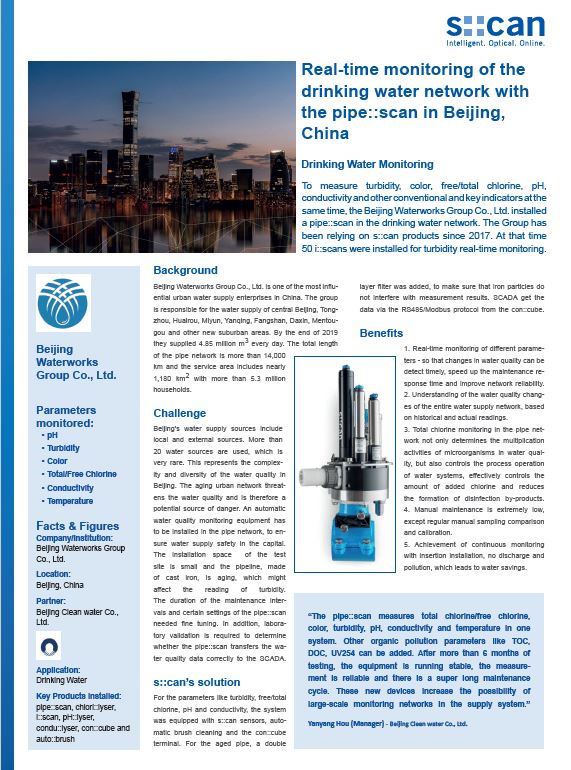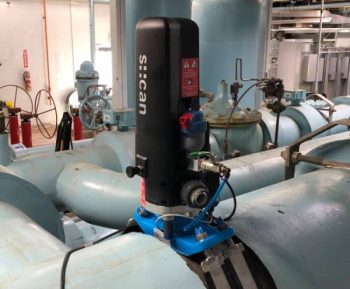To measure turbidity, color, free/total chlorine, pH, conductivity and other conventional and key indicators at the same time, the Beijing Waterworks Group Co., Ltd. installed a pipe::scan in the drinking water network. The Group has been relying on s::can products since 2017. At that time 50 i::scans were installed for turbidity real-time monitoring.
Real-time monitoring of the drinking water network in Beijing

Hintergrund
Background
Beijing Waterworks Group Co., Ltd. is one of the most influential urban water supply enterprises in China. The group is responsible for the water supply of central Beijing, Tongzhou, Huairou, Miyun, Yanqing, Fangshan, Daxin, Mentougou and other new suburban areas. By the end of 2019 they supplied 4.85 million m³ every day. The total length of the pipe network is more than 14,000km and the service area includes nearly 1,180 km² with more than 5.3 million households.
Challenge
Beijing’s water supply sources include local and external sources. More than 20 water sources are used, which is very rare. This represents the complexity and diversity of the water quality in Beijing. The aging urban network threatens the water quality and is therefore a potential source of danger. An automatic water quality monitoring equipment has to be installed in the pipe network, to ensure water supply safety in the capital.The installation space of the test site is small and the pipeline, made of cast iron, is aging, which might affect the reading of turbidity. The duration of the maintenance intervals and certain settings of the pipe::scan needed fine tuning. In addition, laboratory validation is required to determine whether the pipe::scan transfers the water quality data correctly to the SCADA.
s::can’s solution
For the parameters like turbidity, free/total chlorine, pH and conductivity, the system was equipped with s::can sensors, automatic brush cleaning and the con::cube terminal. For the aged pipe, a double layer filter was added, to make sure that iron particles do not interfere with measurement results. SCADA get the data via the RS485/Modbus protocol from the con::cube.
Benefits
- Real-time monitoring of different parameters– so that changes in water quality can be detected timely, speed up the maintenance response time and improve network reliability.
- Understanding of the water quality changes of the entire water supply network, based on historical and actual readings.
- Total chlorine monitoring in the pipe network not only determines the multiplication activities of microorganisms in water quality, but also controls the process operation of water systems, effectively controls the amount of added chlorine and reduces the formation of disinfection by-products.
- Manual maintenance is extremely low, except regular manual sampling comparison and calibration.
- Achievement of continuous monitoring with insertion installation, no discharge and pollution, which leads to water savings.
Related Posts
-
Achieving operational excellence –
How the pipe::scan transformed water quality monitoring Union Water Supply System (UWSS), an Ontario Clean Water Agency managed facility, is responsible for servicing 66,800 residents in the…
Union Water Supply System (UWSS), an Ontario Clean Water Agency managed facility, is responsible for servicing 66,800 residents in the… -
“Österreich radelt zur Arbeit” – Summary
 June 2023 I The “Österreich radelt zur Arbeit”-campaign has come to an end and we take stock. In May, our…
June 2023 I The “Österreich radelt zur Arbeit”-campaign has come to an end and we take stock. In May, our… -
Wings For Life World Run 2023
 May 2023 I On 7 May, the Wings For Life World Run took place for the 10th time. Nine s::can…
May 2023 I On 7 May, the Wings For Life World Run took place for the 10th time. Nine s::can…



